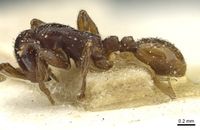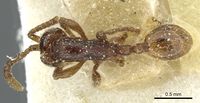Aenictus congolensis
| Aenictus congolensis | |
|---|---|

| |
| Scientific classification | |
| Kingdom: | Animalia |
| Phylum: | Arthropoda |
| Class: | Insecta |
| Order: | Hymenoptera |
| Family: | Formicidae |
| Subfamily: | Dorylinae |
| Genus: | Aenictus |
| Species group: | rotundatus |
| Species complex: | rotundatus |
| Species: | A. congolensis |
| Binomial name | |
| Aenictus congolensis Santschi, 1911 | |
Identification
Gómez (2022) - A member of the rotundatus species complex in the Aenictus rotundatus species group. Identification of A. congolensis is quite straightforward in the rotundatus group due to its developed propodeal ridge and sparse, adpressed white setae and long, digitiform subpetiolar process. The other two species with developed propodeal ridge (Aenictus nyuyi and Aenictus weissi) present erect to suberect setae and poorly developed subpetiolar process.
Mesosomal sculpture may be quite variable among individuals, varying from completely and deeply reticulated to individuals with glassy dorsal mesosoma, petiole and postpetiole.
Keys including this Species
Distribution
Identification
Keys including this Species
Distribution
Latitudinal Distribution Pattern
Latitudinal Range: 6.216666667° to -12°.
| North Temperate |
North Subtropical |
Tropical | South Subtropical |
South Temperate |
- Source: AntMaps; Gomez, 2022
Distribution based on Regional Taxon Lists
Afrotropical Region: Central African Republic, Congo (type locality), Gabon, Zambia.
Distribution based on AntMaps
Distribution based on AntWeb specimens
Check data from AntWeb
Countries Occupied
| Number of countries occupied by this species based on AntWiki Regional Taxon Lists. In general, fewer countries occupied indicates a narrower range, while more countries indicates a more widespread species. |

|
Estimated Abundance
| Relative abundance based on number of AntMaps records per species (this species within the purple bar). Fewer records (to the left) indicates a less abundant/encountered species while more records (to the right) indicates more abundant/encountered species. |

|
Biology
Castes
Known only from the worker and queen castes. Table of castes known for all Afrotropical Aenictus species.
Worker
Images from AntWeb
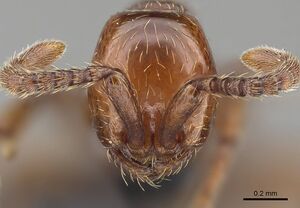 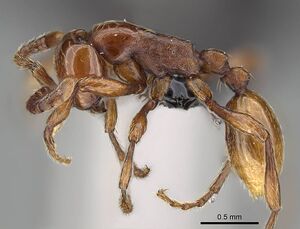 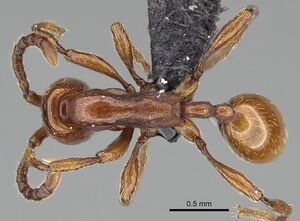 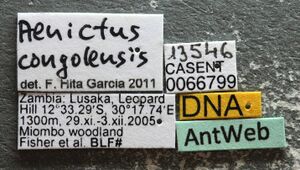
| |
| Worker. Specimen code casent0066799. Photographer Michele Esposito, uploaded by California Academy of Sciences. | Owned by CAS, San Francisco, CA, USA. |
Queen
Images from AntWeb
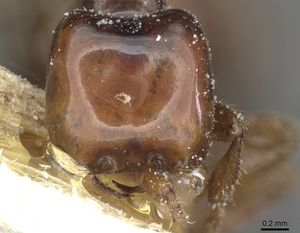 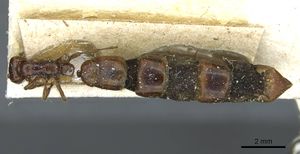  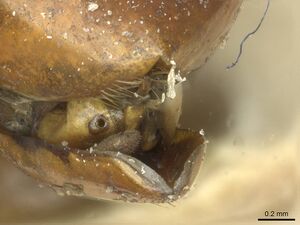 
| |
| Syntype of Aenictus congolensis. Queen (alate/dealate). Specimen code casent0911419. Photographer Z. Lieberman, uploaded by California Academy of Sciences. | Owned by NHMB, Basel, Switzerland. |
Nomenclature
The following information is derived from Barry Bolton's Online Catalogue of the Ants of the World.
- congolensis. Aenictus rixator var. congolensis Santschi, 1911g: 207 (w.) CONGO.
- Type-material: holotype worker.
- Type-locality: Congo (“Congo français”): (no further data) (A. Weiss).
- Type-depository: NHMB.
- Santschi, 1917a: 277 (q.).
- Status as species: Santschi, 1917a: 277 (redescription); Wheeler, W.M. 1922a: 751; Bolton, 1995b: 59.
- Distribution: Congo, Gabon.
Unless otherwise noted the text for the remainder of this section is reported from the publication that includes the original description.
Description
Worker
Worker (Translated from the original): Length 2mm. Thorax, posterior half of the head and petiole dark reddish brown, the rest borwnish yellow. Head, postpetiole and gaster smooth and shiny. Thorax and petiole matt, reticulated, punctuated (like a thimble) over almost the whole propodeum. Mandibles very finely reticulated and finely striated. Pilosiy short, decumbent, yellowish, all over body and legs. Mandibles with 3 to 6 teeth, the apical longer than in ceylonicus. Funicular segments 3 to 7 wider than long. The rest like the type.
Gómez (2022) - HL: 0.57 [0.51-0.62]; HW: 0.51 [0.46-0.56]; SL: 0.40
[0.35-0.43]; WL: 0.91 [0.79-1.01]; PL: 0.22 [0.19-0.25]; PH: 0.16 [0.15-0.18]; PPL: 0.18 [0.16-
0.20]; PPH: 0.13 [0.12-0.14]; CS: 0.54 [0.48-0.59]; CI: 89 [85-94]; SIL: 70 [67-74]; SIW: 78
[72-85]; WL/HW: 178 [164-191]; PI: 134 [126-143]; PPI: 135 [123-153]; CSR: 122; (n=11).
Scapes relatively long, almost reaching three quarters of head (SIL~70). Funicular segments 1- 2 slightly longer than wide, 3–8 subquadrate, apical about twice longer than wide. Head rectangular, longer than wide (CI~90), convex laterally and widest at the middle. Occipital line straight to slightly concave. Ventrolateral margin present, weak, continuing to one third of its length. Mandibles long, with a sharp apical tooth, a preapical tooth and 5-10 smaller denticles. Clypeus a row of 10–12 conical teeth, clearly visible and longer than wide, the two central between the antennal sockets smaller. Frontal ridges present, not projecting frontally, fused between the antennal sockets and diverging apically.
Pronotum and mesonotum weakly convex, propodeum flat, mesopropodeal suture weak. Transverse mesopleural groove not present. Mesometapleural suture present but very weak; propodeal ridge developed and projecting as a horizontal shelf in dorsal view; propodeal declivity concave.
Petiole subsessile with anterolateral and anterodorsal ridges present, dorsolateral ridge absent. Petiole with an anterior slope a quarter of ellipse, dorsal slope flat and vertical posteriorly, posterodorsal angle straight, not rounded. Postpetiole rounded, with a vertical posterior face, without carinae or ridges of any kind. Subpetiolar process developed with a bulky ellipsoidal process longer than high, followed by a subrectangular rounded lamella oriented 45 degrees forward.
Head, legs and gaster glassy smooth; mandibles finely horizontally rugulose, scapes and funiculus punctuated, shagreened; mesosoma variable, from completely reticulated (including pronotum) to individuals with pronotum, dorsum of mesonotum, petiole and postpetiole smooth; mesopleurae, propodeum and lateral sides of petiole and postpetiole always reticulated. Overall colour brown to dark brown, sometimes slightly lighter at gaster and legs. Short, adpressed white setae, oriented backwards, present at head, dorsum of pronotum petiole, postpetiole and gaster. No pubescence noted.
Type Material
- Syntype, GABON: Mayomba. (1w) [CASENT0911420] NHMB [Examined by Gomez, 2022]; Syntype, CAMEROON, Grand Batanga (1w) [CASENT0911445] NHMB [Examined by Gomez, 2022].
References
- Gomez, K. 2022. A revision of the Afrotropical species of the Dorylinae ant genus Aenictus (Hymenoptera: Formicidae) based on the worker caste. Belgian Journal of Entomology 124: 1–86 (doi:10.5281/zenodo.5898821).
- Santschi, F. 1911g. Nouvelles fourmis du Congo et du Benguela. Rev. Zool. Afr. (Bruss.) 1: 204-217 (page 207, worker described)
- Santschi, F. 1917a [1916]. Description d'une nouvelle reine de Formicide du genre Aenictus Shuckard. Ann. Soc. Entomol. Fr. 85: 277-278 (page 277, queen described, raised to species)
- Wheeler, W. M. 1930j. Philippine ants of the genus Aenictus with descriptions of the females of two species. Journal of the New York Entomological Society. 38: 193-212.
References based on Global Ant Biodiversity Informatics
- Baroni Urbani C. 1977. Katalog der Typen von Formicidae (Hymenoptera) der Sammlung des Naturhistorischen Museums Basel (2. Teil). Mitt. Entomol. Ges. Basel (n.s.) 27: 61-102.
- IZIKO South Africa Museum Collection
- Santschi F. 1917. Description d'une nouvelle reine de Formicide du genre Aenictus Shuckard. Annales de la Société Entomologique de France 85: 277-278.
